Content [show]

Lily is a flower of amazing beauty. Therefore, many gardeners in our country find a place for him in their beds for both commercial and personal aesthetic reasons.
The ancestors of the garden lily come from the mountains of Asia. The plant was brought to Europe by the Crusaders along with other bulbous cultures. In knightly times, the white lily was considered a symbol of purity and purity, a symbol of the Virgin.
More than a hundred species of lilies are known in nature. Every year the market is enriched with more than three hundred new varieties. Domestic flower lovers know not all of them.
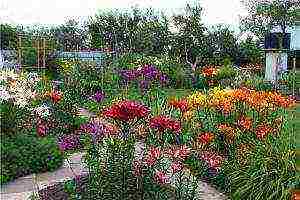
Lilies in the country are very beautiful
The most popular races of lilies in the Russian Federation are hybrids of Asian species. Among them are pink and white Marseille, Marlene, Kentucky, Vermere, Ventu; yellow and red guitana, grand cru; coffees with scarlet ends lollypon, yellow kansas.
Our growers also love oriental varieties of lilies: white with crimson barbados, white with pink set point, white with yellow time-out, white with yellow and pink star class, tricolor arena.
These plants seem to come in all shades you can think of: bestseller and swing apricot lilies, Royal Parade reds, Royal Club coffee pink, Lemon aerobics, bluish blue Ice, cherry stargazers, golden orange aristo ...
The varieties differ from each other not only in colors, but also in shape and weight: from heavy and dense Dutch to airy and fragile creations of Russian breeders, which have corresponding romantic names: virinea, nochka, pink haze.
Water lily
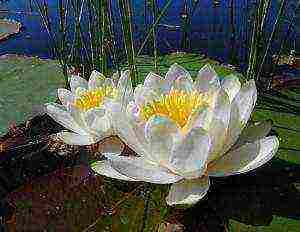
White water lily is very rare
The most famous wild species of this genus in our country is the water lily (nymphea). It is considered good luck to find this white flower, majestically floating in a forest pond among simple water lilies.
Now in the wild, this species has become rare and is protected by law. But they can decorate a small pond in a personal cottage.
Raising a nymph is not a problem. Planting material can be purchased at the store. Next, you need to take a basket with holes, line it with burlap from the inside, pour it inside the clay soil. Plant a water lily in it and cover the soil with small pebbles. Then lower the basket filled in this way to the bottom of the reservoir.
Nymphaea grows well and reproduces well. Once a season, you will need to pull out the basket and put the fertilizer for flowers in the form of a stick there.
When the leaves of the water lily die off in the fall, the basket with the lily must be taken out of the water, put in a suitable container at home and poured over with tap water. At room temperature, the nymphs will fall asleep until spring.
It is not necessary to pour water out of the reservoir for the winter. However, it is worth updating it in the spring.
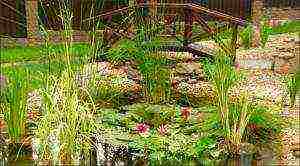
Growing a water lily in the country is not difficult
Choosing a place for a garden lily
Garden lily has been growing in one place for several years. Transplants slow down the development of the plant. Therefore, a place for planting a flower must be chosen so as not to disturb it for the next four years.
Lily can grow on almost any soil. But he prefers loose fertile soil.
On a sunny meadow, lily flowers will turn out to be the brightest. Thanks to the original arrangement of the bud, when direct sunlight hits the main color of the variety, more pearlescent overflows of various shades are added.

Bulbs must be large and healthy
In the shade, on the contrary, the flowers will be standard red or yellow, another pure color. It is also beautiful, but the miracle does not happen either in the garden, or if the flower is cut as a gift or for sale.
We buy bulbs
When purchasing bulbs, you need to pay attention to their condition. They should be healthy, fleshy, large, without overdried scales. Buy them in early spring. You can buy bulbs in the fall. The last date for their disembarkation is mid-October.
People with allergies are better off buying odorless varieties. This is usually indicated on packages by labeling.
Before planting, the tubers are stored in a package in a cool, dark place, preferably well-ventilated. The lower drawer of a household refrigerator is ideal for this purpose.
The condition of the bulbs should be checked regularly. Noticing that the plant has started to grow, cut the package where it is directed. This will prevent deformation of the future stem.
Fertilizers

Fertilizers in granules work best
Mineral fertilizers in granules are best suited for growing lilies. They are brought in twice a year. In the spring - fertilizers with nitrogen, they are put into the soil as soon as the first shoots break out of the ground. In October, the bed is sprinkled with nitrogen-free fertilizing.
For better development, plants are watered with a solution of beneficial microorganisms. These solutions are now sold in stores.
Most florists are convinced that it is absolutely impossible to use organic fertilizers for growing lilies. However, there are many supporters of a diametrically opposite point of view.
They believe that the use of mineral fertilizers depletes the soil and weakens the plants, reducing their resistance to natural adversity. Instead, it is recommended to fertilize the soil with diluted humus.
Who to listen to, check by experience or find out in conversations with neighbors. It can be assumed that it all depends on the variety of lilies and the characteristics of the soil in your area.
To protect plants from pests and prevent diseases, wood ash must be added to the soil, sprayed with a 1% solution of Bordeaux liquid three times per season.
Landing
-

Lilies can be planted at any time
Lilies can be planted in spring, summer and fall. The ideal time to plant lilies is September. At this time, the plant is at rest and most easily tolerates planting and transplanting, because by the fall it has developed perennial roots.
- Before planting, the bulbs are dipped for twenty minutes in a weak solution of basezol (0.2 percent), then for an hour in a growth biostimulator (epin is suitable). The roots of the bulbs must be shortened to a maximum of five centimeters, and the dead scales must be removed.
- We make holes with a spatula fifteen centimeters deep and no more than forty in diameter.
- At the bottom of each hole we pour a three-centimeter layer of gravel, on top of it we pour a five-centimeter layer of fresh soil.
- Gently put the bulbs in the holes, cover them with the same soil, lightly ram.
- With your finger, draw circles on the ground at the site of planting the bulbs. Pour a handful of fertilizer granules into each circle.
- Water abundantly and wait for the water to be completely absorbed into the soil.
- We fill up the holes again, without watering.
Subtleties and landing options
-
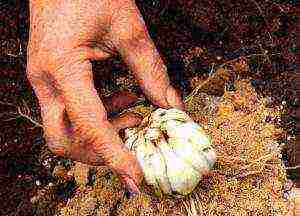
Lily is planted upside down
Depending on the time of planting, the ultimate goal of the florist, the type and variety of lilies, the quality of the soil, the planting method may vary.
- Usually the bulbs are planted with the bottom down. But if it is necessary that they spontaneously reproduce in the future, they are laid on their side when planting. In this case, the shoot stretches to the side, overgrowing under the ground with a large number of large children. Only at some distance from the original hole, the trunk will begin to grow upward. Babies will bloom one year after the mother's bulb is planted. This method is especially effective for spring planting, but it is also used in autumn.
- When planting oriental varieties, do not overdry the bulbs. Asiatic lilies do not tolerate the introduction of lime into the soil. They need to be replanted every two years.
- In principle, lilies are not afraid of weeds. Of course, when planting, it is better to remove them from the site. In the future, it will be necessary to regularly pull the shoots of the bindweed from this garden bed, which obsessively interferes with the life of the lily. Weeding it among mature plants is rather inconvenient.
Care
- Lilies winter well outdoors. It is not necessary to cover them at this time. They are not afraid of frost. Hybrids la, from, Asian differ in increased frost resistance. Before wintering, a handful of peat is poured onto each plant.
-

Lilies are unpretentious and not afraid of the cold
Tubular and oriental varieties are more capricious. Therefore, some gardeners still prefer to cover flowers for the winter. Spruce branches, sawdust, dry leaves, film are used for this purpose.
- In the spring, the shelter must not be forgotten in time - as soon as the snow melts, before the shoots break through. If this is not done in a timely manner, the bulbs will begin to sprout directly underneath. As a result, you will get weak and pale plants that will be easily damaged by the rays of the sun. They may not bloom this year.
- In order to somehow save the situation, in this case, you will not have to remove the entire cover. Let it protect the weakened growth from ultraviolet radiation.
- Lilies do well in the garden if their bulbs do not overheat. Therefore, it is better to keep their "legs" in the shade, and "head" - in the sun. To ensure this, low-growing plants are planted next to the lilies: flax, bells, hosts, daylilies.
- Lilies are unpretentious. During flowering, they do not require abundant watering. It is needed only during drought periods. When the plants have faded, watering can be stopped altogether.
- The soil is carefully loosened with a thin rake or a trident hoe even before the emergence of shoots. This will help the soil retain moisture. In moist, well-heated soil, lilies grow rapidly and form a developed root system.
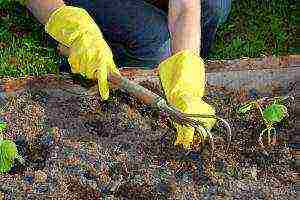
Weeds need to get rid of
- At the same time we are weeding the garden bed. We pull out large weeds. Small ones will die themselves. Lilies do not germinate at the same time: first - large bulbs, then smaller ones. Until they all rise, loosening the soil must be interrupted. The stalks broken at the same time cannot be restored.
- To stimulate root germination and better reproduction, plants are spud. Rounded stems are overgrown with roots. The more roots there are, the larger the flowers will be.
- Water the lilies at the root, without wetting the leaves. Fungi can settle on wet leaves.
- After a heavy rain, the soil is loosened by five centimeters. Then it will stay moist longer. Along the way, kill the weed seeds and reduce the humidity around the leaves. As a result, the plants will be less sick.
Cutting the flowers
If in summer the weather is not too dry and not very rainy, in most cases, taking into account the above, you can forget about the lilies growing in the garden for a while, returning to the garden only to cut flowers. With other problems, they will perfectly cope with themselves.
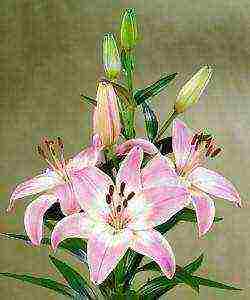
Lily needs to be cut with buds
- When cutting the buds, leave most of the stem with leaves to the plant.With it, the bulb will develop well further.
- In autumn, the buds are cut at a height of 8-18 cm from the soil.
- Make the cut obliquely. Then the water will easily slide off the stem without getting inside. This will prevent rotting.
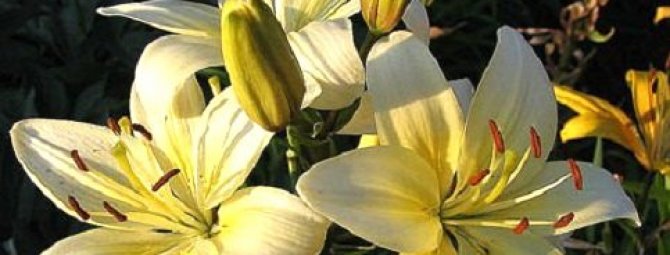
- Type: lily
- Flowering Period: May, June, July, August, September, October
- Height: 20-250cm
- Color: white, yellow, orange, red, spotted, two-colored
- Perennial
- Hibernates
- Sun-loving
- Moisture-loving
Lily is an amazingly beautiful flower with a pleasant aroma that has been revered in many cultures. The Greeks attributed divine origin to her, believing that the lily grew from the milk of Juno - the mother of the gods. And when literally translated from Greek "li-li" sounds like "white-white". The Romans revered her as the main flower at festivals celebrating the goddess of spring Flora. Christians and Jews adorn their sacred altars with it, considering the lily a symbol of purity. This flower can be found on the coats of arms of noble families of different countries. Today, lilies adorn many parks and suburban areas, acting as a bright accent in any flower garden. One of the prerequisites for the lush flowering of these marvelous plants is the correct planting of lilies and their care.
The main groups and popular varieties of lilies
According to the international classification, these flowering perennial bulbous plants are divided into 9 groups:
- Asian - include 5 thousand varieties. They are characterized by unpretentiousness and winter hardiness, flowers do not smell.
- Curly - there are 200 varieties. It got its name from the inflorescences that resemble a candlestick with drooping heads.
- Snow white - include 30 varieties. They have a wonderful aroma, they can have a pale yellow color. They are very moody.
- American - there are 140 varieties. The flowers are very original in bright exotic colors, often decorated with two-tone black specks. Quite finicky.
- Long-flowered - have an elongated bud shape with a direction to the side or downward, Extraordinarily fragrant. In garden conditions, they often suffer from viral diseases, they are mostly grown as greenhouse crops.
- Tubular - have a characteristic flower shape, reminiscent of an elongated gramophone, collected from dense wax petals. Capricious, in need of shelter for the winter.
- Oriental (oriental) - a large group of 1300 varieties. They are capricious, demanding for warmth, often affected by diseases.
- Interspecific hybrids - combine the best qualities of individual groups. Extremely beautiful and exotic. Among the varieties obtained as a result of crossing, the most popular are LA hybrids, OT hybrids and LO hybrids with large flowers up to 25 cm in diameter for distillation.
- Natural species - play a key role in the creation of new varieties.
Under natural conditions, these herbaceous plants are ubiquitous in the temperate latitudes of the Northern Hemisphere: in the Mediterranean, southeastern part of Central America, Japan, and China. Asian lily hybrids are most widespread in mid-latitudes.

Lilies are one of the most beautiful representatives of the bulbous genus. They belong to the daylily family and are relatives of onions, hazel grouses, tulips.

Asians come from natural species of Siberian lilies, such as Daurskaya and Tigrovaya, and therefore the most winter-hardy and adapted to not so favorable climatic conditions. Other groups of lilies, such as oriental, tubular or curly lilies, require more careful maintenance.
Among Asian hybrids, varieties are distinguished by the greatest decorativeness:
- "Marlene" - petals of a delicate pink hue. It is famous for its abundant flowering.
- "Landini" is a spectacular maroon beauty over a meter high.
- "Aphrodite" is a double flower with pink petals.
Of the old and time-tested varieties, it is also worth highlighting: "Inchantment" with flowers of a rich red-orange hue, "Destin" with delicate lemon-yellow petals, "Peprike" with bright red flowers.

Worthy representatives of the Orientali group can be considered: "Mona Liza" with graceful pale pink flowers, "Tiber" with lilac flowers framed by a white border, snow-white beauty "Siberia"
The choice of planting material
When choosing planting material, it is important to take into account the climatic features of the area, since not all lilies are able to painlessly tolerate temperature fluctuations.
When purchasing planting material, carefully examine the bulb: there are no spots and traces of rot on it. These signs indicate the defeat of the plant by diseases. The bulb should be evenly colored, the scales should adhere tightly to each other.
The marking will help to determine the varietal affiliation of the plant:
- The first Roman numeral denotes a lily group;
- The second digit indicates the position of the flower ("a" - directed up, "b" - to the side, "c" - down);
- The letter through the fraction denotes the shape of the flower ("a" - tubular, "b" - cupped, "c" - flat, "d" - turban).
It is best to store the bulbs in a cool place until planting, sprinkling with sand, sawdust or damp moss. Some adapt the bottom shelf of the refrigerator for this purpose.
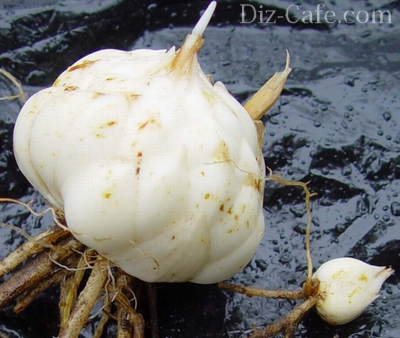
For spring planting, choose bulbs on which sprouts have already hatched and short white roots have begun to grow
In the case when the bulb begins to germinate ahead of time, it is advisable to plant it in a flower pot, leaving it in a warm room. It is worth replanting into open ground after frost.
Choosing a seat for landing
When planning where to place an exotic beauty on a site, you should focus on her group affiliation. Tubular, Asian and Eastern lines show the greatest decorative effect only in well-lit areas.
They feel comfortable in the partial shade of lilies, which have adventitious roots on the underground part of the stem. These include varieties of the group of curly lilies. It is advisable to place them so that the root part is shaded, and the inflorescence is illuminated by the sun's rays.

Lily is a heat-loving plant that prefers well-lit areas, reliably covered with a "screen" of green foliage from gusts of wind
Lilies with large flowers look spectacular in solo performance. When planting small-flowered lilies, in order to obtain an expressive aesthetic effect, it is better to form small groups, placing them at a distance of 10-15 cm from each other. Against the background of the lush foliage of other perennials, bright graceful flowers will stand out favorably, creating a magnificent picture.
Sites located on a small hill are ideal for planting flowers. This prevents stagnation of rainwater, which often causes damage to plants by pathogens. Swampy soils are destructive for fastidious beauties. It is possible to improve the conditions on clay and heavy loamy soils by arranging drainage. For this, ditches are laid, placing them at a slight slope. The bottom of the ditches is lined with a layer of crushed brick or fine gravel, sprinkled with river sand on top and covered with earth.
So that the soil near the root area of the flower is in the shade and does not overheat under the sun's rays, it is better to plant daylilies, bells and hosts in the immediate vicinity. Their spreading foliage will cover the surface of the earth, creating optimal conditions for the development of fastidious beauties.
Correct soil preparation
Correct soil is 80% of success in growing lilies. Regardless of the group belonging to the bulbous, they all prefer to grow on rich soils.

On enriched and well-drained peat soils, varieties of the American group and oriental hybrids thrive.
Humus is considered the best fertilizer for lilies. But it should be introduced with caution: with an excess of nutrition, the plants begin to "fatten". This provokes their slowdown in development, a decrease in disease resistance and a decrease in frost resistance.The optimal ratio of the introduced humus is 7-8 kg per 1 sq. M.
The introduction of poorly decomposed manure containing pathogenic microflora with pathogenic plants can have a detrimental effect on plants.
The soil under these flowering herbaceous plants must contain a sufficient amount of nutrients, because a plant can live in one place from 3 to 5 years. When digging the soil, it is filled with mineral fertilizers, which include nitrogen, potassium and phosphorus. They are brought in at the rate of 100 grams per square meter.
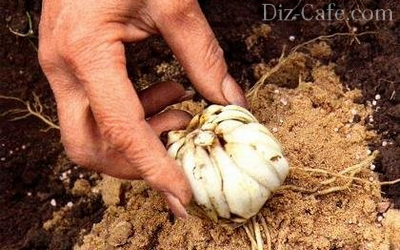
Since the roots of plants go quite deep, they dig up the soil before planting, deepening 30-40 cm.To drain heavy clay soil, sand is added to its composition
Most members of the daylily family do not tolerate acidic soils, preferring slightly alkaline and slightly acidic soil compositions. On acidic well-drained soil, only varieties of the eastern group feel comfortable. Asians and LA hybrids are more fond of neutral and humous soils, and tubular lilies show the greatest decorative effect on poor, slightly alkaline soil with admixtures of ash and sand.
Help reduce the acidity of the soil:
- Wood ash - it is brought in at the rate of 150-200 gr per 1 sq. M;
- Chalk - during digging, 300-500 gr. Per square meter.
Planting material processing
The bulbs are examined before planting, discarding diseased specimens: they remove damaged tissues, cut off rotten scales and dead roots.
The examined material is washed under pressure for 20-30 minutes. Then, in order to prevent the development of fungal diseases, they are first kept in a solution of potassium permanganate, prepared in a proportion of 5 g per 10 liters of water, and then in a solution of the drug foundation. If necessary, they can be etched in an insecticidal solution based on chlorophos and 1% phosphamide.
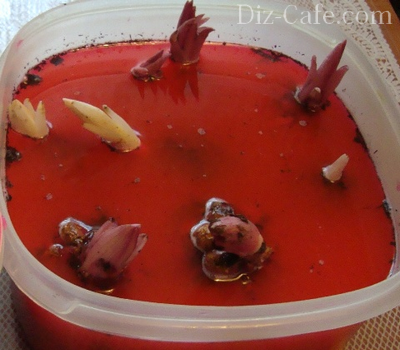
The root system of these plants dries quickly enough. Therefore, after soaking, there is no need to dry them.
Choosing the planting time
The optimal planting time is after the plants have faded. This is the period from late summer to mid-autumn. If the bulbs are purchased in early spring, planting can be done as soon as the soil thaws and dries up. Late spring planting is risky in that young shoots can be damaged.
Spring planting is also more suitable for late-flowering varieties, the bulbs of which are slowly formed. These include LO hybrids and varieties of the eastern group: Rio Negro, White Haven, Rialto, Marco Polo.
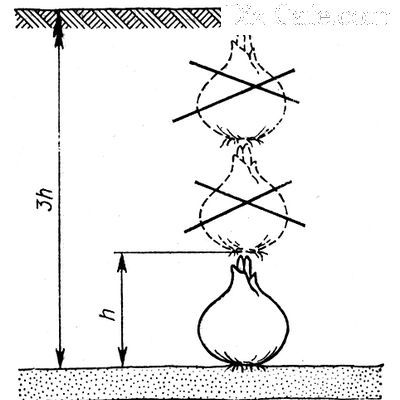
When planting plants, you should be guided by the rule that large bulbs with a diameter of 8-12 cm are planted to a depth of 25 cm, and small ones - to a depth three times the size of the bulb itself
The only exceptions are Chalntcedony, Snow White and Testaceum. They form a root rosette of leaves, and therefore the soil layer above them should not exceed 2-3 cm.
When planting bulbs in heavy soil types, the bottom of the planting pits is covered with a 5 cm layer of sand. To protect them from voles, wire mesh is laid along the inner walls of the planting pit.
The bulb is laid out on the bottom of the pit, placed on an impromptu sand "pillow", and the roots are straightened. They cannot be wrung and bent upwards. The landing site is marked with a peg and sprinkled with earth, lightly tamping. The well is poured abundantly with settled water and covered with bark mulch.
Lilies are very sensitive to root drying. To prevent the bulbs from weathering while the hole is being prepared, it is better to wrap them in a wet napkin or hide them in a box with wet peat. Tender young sprouts are afraid of temperature extremes
To protect young shoots, the planted bulbs are covered with plastic bottles with cut-out bottoms. For this purpose, it is better to use bottles with wide walls with a volume of 2-3 liters.
Subtleties in the care of an exotic beauty
How to care for lilies? To minimize the care of these flowering plants, a number of recommendations must be followed:
- During the season, feed the plants with complex fertilizers and ash at the rate of 50 grams per square meter. Top dressing is carried out in three stages: in early spring, at the stage of bud formation and after flowering. Suitable for spring root feeding: ammonium nitrate (40 g per 10 l), nitroammophosphate (50 g per 10 l), a solution of fermented mullein in a ratio of 1:10.
- Provide timely watering. Although the lily does not like excessive moisture, especially dry days need frequent watering. You need to water at the root, trying not to moisten the leaves. Accidentally falling water droplets can act as a kind of lens, causing sunburn.
- Mulching the soil. Very harmful to bulbous plants and soil overheating, which disrupts the course of biological processes. This can be prevented by mulching the soil with natural materials of light shades (cut grass, straw, sawdust).
- Pest control. The lily beetle and lily fly are dangerous for the aboveground part of plants. You can get rid of pests by collecting the larvae by hand and spraying the stems with preparations such as "Thunder", "Grizzly", "Mukhoed".
- Garter stalks. Tall varieties with thin stems must be tied to supports, thereby preventing them from breaking off and lodging.
- So that wilted inflorescences after flowering do not spoil the picture, they should be removed in a timely manner. The peduncles are removed at the end of the season.
- After the end of the growing season, the stems of the plants must be cut and burned so that in winter they do not serve as a conductor of cold to the bulb.
- For the winter, it is advisable to cover garden lilies with leafy soil, sawdust or spruce branches of conifers. Only Asian and LA hybrids do not need shelter.
Lilies are planted, separating the daughter bulbs, every three years, one and a half months after the end of flowering. By this period, they had built up mass and gained the greatest strength.
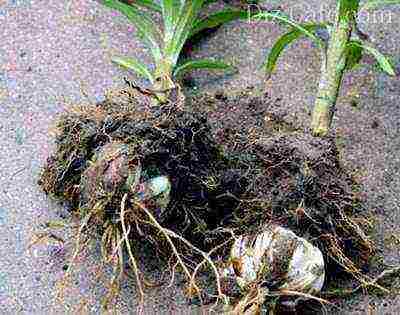
Lilies are planted, separating the daughter bulbs, every three years, one and a half months after the end of flowering. By this period, they had built up mass and gained the greatest strength.
Slowly growing varieties of Caucasian origin are best planted only after 5-6 years. Asian varieties can be replanted even in summer. The main thing is to dig up the plants with a garden pitchfork along with a lump of earth, while preserving the root system.
> When transplanting, baby bulbs are carefully separated from the stem and planted in seedling beds for growing. Immediately after planting, they are sprinkled with compost or manure humus, forming a layer 3-4 cm thick. They will form full-fledged bulbs in the second or third year.
Daylily - lily for the lazy
No wonder the breeders called these unpretentious and disease-resistant perennials "lilies for the lazy." And the statement that the more beautiful the flower, the more capricious it is, is not applicable to this plant. Daylily grows well in any garden soil, feeling comfortable both in the bright sun and in partial shade.
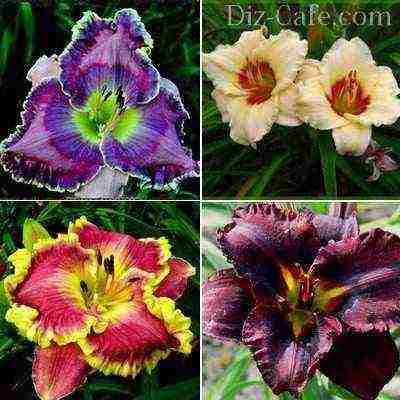
Not inferior in beauty to garden lilies and their closest "relatives" - daylilies, but unlike fastidious beauties, they are very easy to care for
Planting and caring for daylilies takes a minimum of time and effort. And the plant begins to delight with flowering already in the first year of planting. These perennials prefer neutral or slightly acidic soil. They are able to grow on depleted soils, but they show the greatest decorative effect on loose loams rich in organic matter. They are tolerant of infrequent watering, but, like lilies, do not tolerate stagnant water.
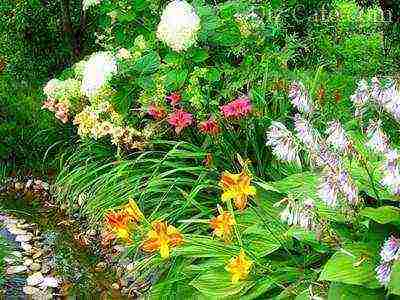
Perfectly combined with ornamental grasses and flowering annuals, they perfectly mask the slow disappearance of spring-flowering bulbs.
Daylilies can become a bright decoration of any flower garden. With the right selection of species with different flowering periods, the flowering of daylilies will not be difficult to stretch for the entire season.
> Rate this article:
(13 votes, average: 4.1 out of 5)
Lilies are the most beautiful and exquisite garden flowers, while growing them in the country is quite simple. Like many types of bulbous plants such as daffodils, this species is absolutely not picky about care and is resistant to adverse environmental factors. Lilies can be planted in any garden plot of the summer cottage, as the plants feel comfortable both in areas open to the sun and in the shade. In addition to the beautiful and long flowering period, which has a positive effect on the landscape design of the summer cottage, many varieties of plants of this species have healing properties. Alcoholic tincture made from white lily petals accelerates the healing of wounds, cuts, burns, relieves toothache and muscle pain.
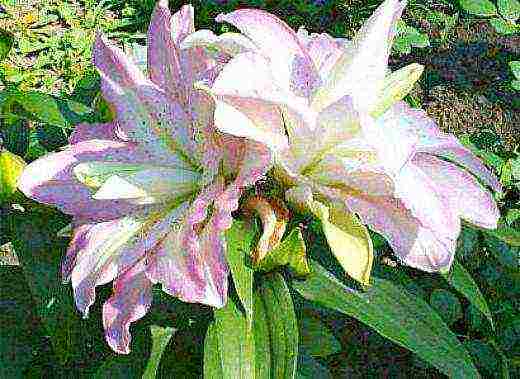

Varieties and groups of lilies
Recently, new beautiful hybrid varieties of lilies have been bred, which can be divided into several groups - Asian, Long-flowered, Curly, Snow-white, American, Tubular. The most refined and beautiful varieties are considered Oriental and Asian hybrids lilies, but, at the same time, the planting of these varieties is the most demanding for the conditions of care. As a result of crossing Eastern and Asian varieties, a new group was bred - OA hybrids. Representatives of this group are unpretentious, frost-resistant and have unusual double flowers of various colors.

When choosing a hybrid plant variety you like, you need to clarify whether the climatic conditions of your region are suitable for growing it. You should not buy varieties with a late flowering period, since the bulbs will not have time to gain the necessary strength before the onset of the first cold weather, which will lead to the death of the plant.

How to grow lilies outdoors
Lilies are perennial bulbous plants, therefore, for planting in the country in early spring, it is necessary to purchase bulbs, preferably small in diameter. You can also plant lilies in early autumn, the main thing is that the flowers have time to adapt to new conditions before the onset of the first frost.
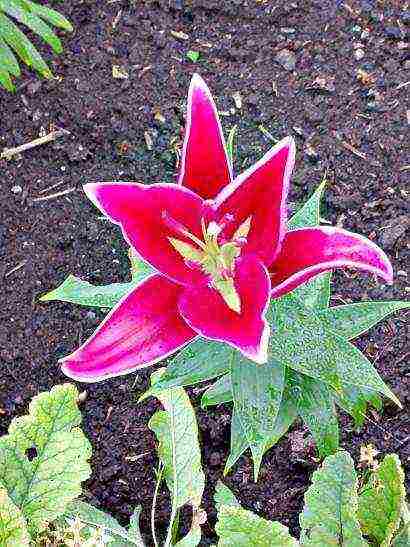
Required soil
The best soil for planting lilies is black soil or loamy soil, but sandy and clay soil is absolutely not suitable for garden flowers. The soil must be loose, nutritious and always permeable. Immediately before planting the bulbs, in a few weeks you need to prepare the soil - uproot the weeds, loosen the soil well and apply potash, phosphorus and nitrogen fertilizers, if necessary, add a small amount of sand and agroperlite.
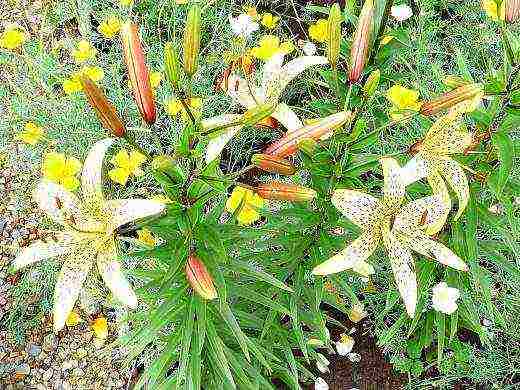
Planting depth of bulbs
The planting depth of the bulbs is determined by the type of lily and the diameter of the bulb itself. Large bulbs need to be planted deep enough in the ground, smaller plant bulbs not very much. The guideline is this: the depth should be approximately three times greater than the diameter of the lily itself. The distance between the bulbs must be at least 25 centimeters. in garden plots, it is best to plant flowers in small groups, no more than 5 pieces.
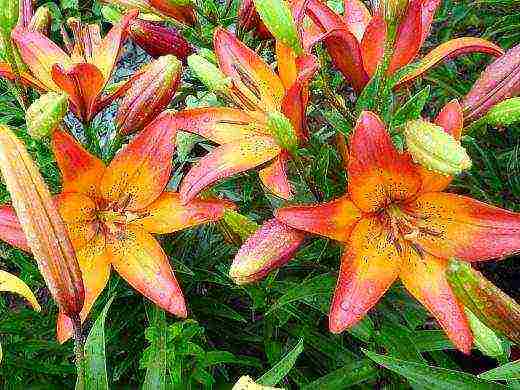
Dig the bulbs with a garden pitchfork, taking care not to damage the root system. The dug out bulbs are carefully shaken off the ground, cleaned of gray and brown spots, washed with warm water, and then placed in a solution of karbofos for several minutes.
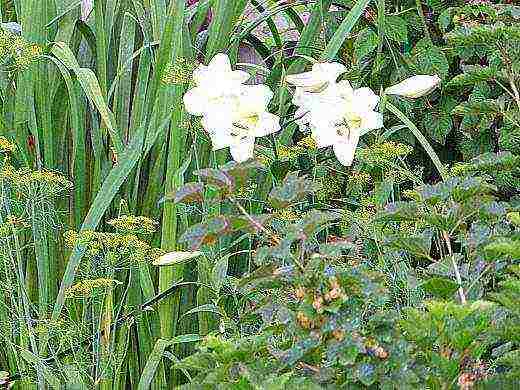
Places for growing flowers
I recommend planting lilies in the country in well-lit sunny places. Especially good lighting should be in the morning. After planting and during the summer, it is necessary to regularly water the flowers, which is necessary for the healthy growth of the plant and the formation of new bulbs.
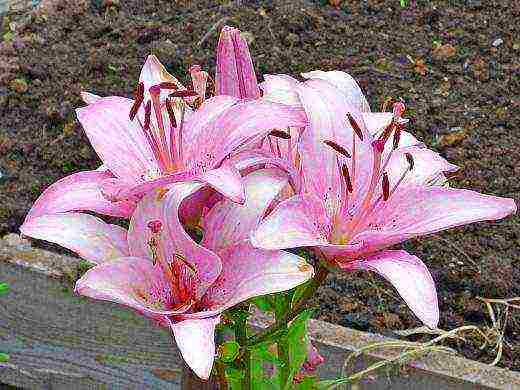
Lily care
Watering
In some varieties of lilies, when grown, the depth of the roots can reach two meters, so it is necessary to shed our beauties only at the root.In this case, the leaves must remain dry.
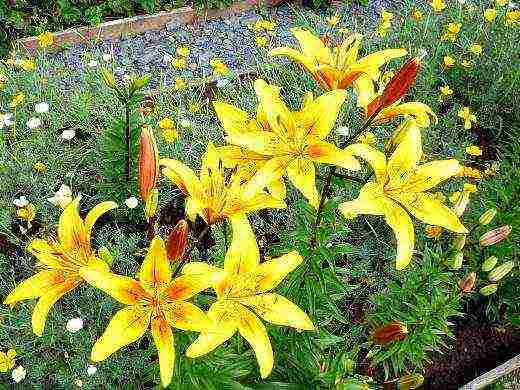
Fertilizing
To stimulate flowering, plants must be fertilized with nitrogen or phosphorus fertilizers. For example, ammonium or calcium nitrate, but fertilizing with organic fertilizers is not recommended. If you regularly feed the plants with wood ash, the flowers will acquire a brighter color and a larger diameter.
Lily blooms greatly weaken and thin the bulb. The recovery period can last from one to two months. During this time, new roots grow and the bulbs accumulate nutrients for the winter. During this period, it is necessary to continue caring for flowers - weeding, removing weeds and treating pests with fungicidal preparations.
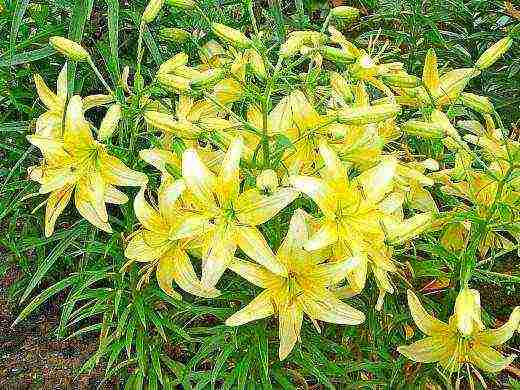
Transfer
Every five years, it is necessary to transplant lily bulbs to a new place, and if necessary, divide them.
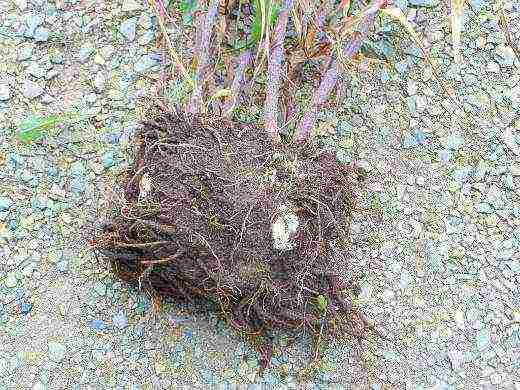
Bulbs overwinter in the soil
For the winter, we do not dig out the bulbs of the dacha Asian and Oriental lilies, despite the severe frosts and piercing winds at this time of the year. Before the onset of the first frost, it is advisable to wrap the bulbs of the eastern representatives a little. For this, peat and spruce branches are suitable.
Lilies - planting and care, varieties and types
Secrets of growing lilies - caring for lilies, proper planting, popular varieties
Similar articles
For the winter, after the autumn rains, lily bulbs are covered with peat, spruce branches and polyethylene. It is especially important to cover Eastern hybrids with a film, because, in their original form, at home, these lilies grow in warm and dry conditions. In spring, covering peat can be left, and spruce branches must be removed as early as possible so as not to damage the sprouts.
The most unpretentious and most suitable for the Russian climate are Asian hybrids and OT-hybrids.
In the literature they write that every 3-4 years, lilies should be dug up, planted, transplanted, and the like. However, in practice, you need to look at what has grown in you. When you see that the chayta's lilies began to grow too densely - then transplant them, plant them further, that is, follow the instructions.
• sand, peat - a bucket per bulb.
Rake off the ground, trying not to disturb the roots, take out the bulb and, pressing lightly on the scales, break off 5-6 outer scales. The break-off point must be disinfected with a solution of potassium permanganate and sprinkled with a mixture of crushed charcoal and sulfur. Then return the onion to its original place and sprinkle with earth.
Place
- Asian hybrid. The plant is 90-100 cm high. The flowers are cupped, looking up; bright yellow with dark specks. The flower is terry, diameter 17 cm. The inflorescences are racemose. Blooms in July. Forms a spectacular, profusely flowering thicket, very good for flower beds.
- Asian hybrid. Height 90-100 cm. The flowers are star-shaped, directed upwards, white, with a rare speck in the center and a yellow spot around the nectary. Filaments are greenish-white. Diameter 15-16 cm. It blooms in July.
- For planting, choose warm sunny areas with well-drained fertile acidic soils. The soil layer above an adult bulb should, on average, be two diameters, but not less than 10-12 cm, and in the northern regions it is even recommended to deepen them to 15-20 cm - this way they will germinate later, and the likelihood of damage to the buds by spring frosts will decrease. Luxurious flowers need enough space to feed - try to maintain a distance of 20-25 cm between the bulbs.
- The flowers are fragrant, tubular, less often cup-shaped or star-shaped, yellow, pink, orange. The outer side of the perianth is often darker than the inner side. Bloom in July-August. They are frost-resistant, prefer good garden soil with the addition of leaf humus. They do not tolerate acidic soils. They are not susceptible to viral diseases and are sufficiently resistant to fungal infections. Need a sunny location and well-drained soil.The flower of tubular lilies is formed outside the bulb - it is laid during the growing season on a flowering stem. Therefore, in the case of late frosts, there may be a lack of flowering or the appearance of defective, ugly flowers.
Longiflorum (Longiflorum)
Lily is one of the famous flower cultures - more than six thousand of its hybrid varieties are known, obtained from crossing various species. In 1962, the American gardener Jan de Graaf systematized the varieties and hybrids of lilies, combining them by origin. This classification was accepted as international in 1964. It will be very useful, especially for beginners, because the most important features, such as soil requirements, resistance to frost, drought or excess moisture, and disease resistance are the same in most lilies.
Asian (Asiatic)
The graceful shape, beauty and ability to stand in water for a long time make it possible to use lilies for various floristic compositions.
Candidum
The successful cultivation of lilies in our climate is possible only if certain conditions are met. For example, tubular hybrids need alkaline soil, other varieties must be covered with foil and spruce branches for the winter. When buying Oriental hybrids, be sure to check their flowering time. Blooming varieties should not be bought too late. bulbs may not have time to gain nutrients for the winter and will die.
Oriental
Lilies in the flowerbed (or even in the garden) would be good to mulch. This protects the flowers from drying out the soil, protects against fungal diseases and weeds.
Trumpet & Aurelian
I'll start with how NOT to plant lilies. They absolutely should not be planted in clay and heavy loam, especially if you have a high level of groundwater or water stands for a long time in spring. Bulbs in such conditions will rot almost guaranteed. (Although some lily professors believe that the American lily is not afraid of such a bay.)
American (American)
Disinfect the scales with a pale pink solution of potassium permanganate, then treat with a solution ("Kornevin", heteroauxin). After processing the flakes, dry and dust with a mixture of crushed coal and sulfur.
Martagon
For lilies in the garden, choose sunny or slightly shaded areas protected from the wind with well-drained soils - from slightly acidic to calcareous. You can clarify what soil requirements are imposed by the varieties of each group in the "Classification" section. Common to all varieties is that they cannot tolerate stagnant moisture. Areas where melt and rain water stagnate are unsuitable for growing lilies, and too heavy clay soils require improvement.
Chianti
Intersectional hybrids of lilies
Salmon classic
- After the surface of the earth is seized by frost, the plantings are covered with a layer of fallen leaves; after the snow melts, this shelter is removed to allow the soil to warm up.
- The flowers are usually turbid, two-colored, with a wine-red speck on a light background. The aroma is weak. Bloom in July. Rare in culture, but well suited for central Russia. They prefer sunny areas. They need abundant watering and slightly acidic soils. Rarely form daughter bulbs, vegetatively reproduce better with bulbous scales.
- Lilies are usually placed in the middle or background of flower beds.
- To keep the lilies longer in the cut state, it is recommended to dip the tips of the stems in hot water for one to two minutes. Good results are obtained by adding silver sulfate and a small amount of sugar to the water. But even without this, lilies remain fresh for quite a long time, delight with beauty and a pleasant aroma.
- Before planting in open ground, lily bulbs purchased in early spring are stored in a refrigerator in a plastic bag filled with dry peat. Under these conditions, the bulbs do not form large shoots.If the bulb purchased in spring has too large a sprout (more than 6 cm), then it is planted in the ground obliquely.
- After flowering, you should never cut out the stems with foliage!
Oriental lilies
Lilies grow well on sandy-peat soil, but the peat should not be very acidic. If you know (or guess 😛) that your soil is highly acidic - pour ash! Ash is just what you need, it will deacidify the soil, and at the same time enrich it with potassium, phosphorus and many trace elements. The lilies will appreciate it. Don't overdo it - lilies don't like alkaline soil either.
When the scales are separated in the spring, they can be planted directly into the open ground - after 5-6 cm, with row spacing of 20-25 cm, deepening by 2/3 of the height. Mulch the soil with peat chips or humus, shade the plantings. Do not let the soil dry out! In the fall, the small bulbs formed from the scales can be planted for growing.
What to plant lilies with - compatibility
The soil
Secrets of planting oriental lilies
Asian hybrid. Plant height 90-120 cm, flower 8-15 cm in diameter, goblet, opens wide, directed upwards. The petals are pale pink, delicate shade. Blooms profusely in July or 90 days after planting, thrives well.
LA hybrid. Height 80 cm. Flowers are cup-shaped, directed upwards, pinkish-orange in color with a darker center. Blooms in mid-July, with spring planting - 70 days after germination of the bulbs.
The main secret of a successful wintering of an oriental lily is that the soil must be dry. In the fall, wait until dry weather settles for a while, and cover the plantings with waterproof material. The place should be level, without a slope, so that water does not flow under the shelter. It will not be noticeable in a flower garden if flowers are planted around them, which grow luxuriantly in late summer and autumn: buzulnik, sapwood, helenium, perennial asters.
The flowers are turbid, of various colors, with dark spots on the inner side of the perianth lobes. The aroma of flowers is weak.
Try to arrange them so that other plants obstruct about half of the stem on all sides, from where the flower garden is visible. Then the shoots of lilies that turn yellow after flowering will not be conspicuous. In the foreground, hosts, geychera, geraniums, lavender, hyssop, stachis, brunner and other crops with beautiful leaves that retain their decorative effect throughout the season will look good. In the intervals between the groups of lilies or behind them, you can plant perennial asters, phlox, echinacea blooming in autumn. Their aboveground part grows noticeably, becomes more luxuriant after the flowering of most varieties of lilies. In such a composition, the plants located next to the lilies will almost close together in the second half of summer, and the space vacated in the flower garden above the bulbs will become imperceptible.
How to plant lily bulbs in the garden. Tips for growing flowers Lilies in the country. Useful tips for gardeners and gardeners on growing vegetables and fruits ====================================== = - ==========
Asiatic lilies
As a rule, large lily bulbs are planted to a depth of 10-12 cm, small ones by 7-8 cm. That is, approximately so that the planting depth is three times the diameter of the bulb itself.
For some reason, a large part of flower lovers do not know this.
❗ Attention!
Secrets of planting asiatic lilies
- In the spring, after removing the shelters from the plantings of heat-loving varieties, the surface layer of the soil is loosened to retain moisture. Until the plants have bloomed, they need sufficient, but not excessively moist soil. To prevent the roots from overheating and drying out, it is recommended to mulch the soil with humus or peat chips. At the end of flowering and for some time after its end, the plants are watered at the root, trying not to wet the leaves. In autumn, after the transition of lilies to a dormant state, it is recommended to cover areas with oriental hybrids with a waterproof film.
- Lily roots penetrate to a depth of 60 cm.Therefore, the soil is cultivated to a depth of 40-60 cm.1 bucket of sand and peat is added to a heavy-textured soil, and 1 bucket of peat per 1 m2 is added to a light soil. In addition, for each square meter of plantings, 2-3 buckets of well-rotted manure are introduced (it must mature for at least three years) and the soil is filled with phosphorus and potassium fertilizers (100 g of superphosphate and 50 g of potassium sulfate per 1 m2). For varieties that prefer slightly alkaline and calcareous soils, 200-500 g of wood ash or chalk are introduced, under oriental lilies and OT-hybrids, gravitating to slightly acidic soil, a mixture is prepared from equal parts of peat, turf soil and humus and spilled with a strong solution of potassium permanganate or in the usual potting mix for lilies, coniferous litter.
- Fragrant lilies with exquisite large flowers are not only for sophisticated florists. By carefully reading the recommendations in this issue of the magazine, you can grow them, even if you do not have much experience. You just need to put in a little more effort.
Barcelona
It is easier to grow orientals in a container than in flower beds, and who would refuse the opportunity to put fragrant flowers on a terrace, patio, balcony? Bulbs can be purchased in the off-season at a discount - they are planted at any time. Choose varieties up to 50 cm tall. The main thing is that the container with growing lilies does not dry out and overheat. After flowering, stop watering and keep the bulbs dry, and for the winter, move the container to a cool place with a temperature no higher than 5 ° C.
The most frost-resistant among lilies, durable plants, are not susceptible to viral diseases, almost do not suffer from gray rot and are rarely affected by fusarium. They grow in one place for a long time, they do not tolerate a transplant. They prefer partial shade. They need regular watering, they are undemanding to the soil. They grow slowly, rarely form daughter bulbs, so they are propagated mainly by bulbous scales.
Lily varieties
Recently, undersized varieties of lilies with a stem height of up to 30 cm have been popular. In the middle plan of a mixed flower garden, they are almost invisible. They are sometimes recommended for rockeries. But against the background of stones or pebble dumping, they are too clearly visible, and after flowering, when it is still impossible to remove the yellowing shoots, so as not to disrupt the development of the bulb, they look ugly. These varieties are suitable for planting among soil-blooming plants with a shallow root system - creeping phlox, gypsophila in rockeries or in the foreground of a flower garden.
- Search and compare prices for flights
- The distance between the bulbs should be approximately 20-25 cm for large lilies and 10-15 cm for small ones.
- That is, it is you - you probably know, but most of my acquaintances - for some reason, unlike you - do not know.
- Note again - this applies to
- When the first leaves appear, the plants are fed with mullein solution (1:10) or full mineral fertilizer (40-50 g per 1 m2). Repeat during the period when the plants are picking up the buds and during the coloring of the buds, but no later than August 15. For most varieties, with the exception of those preferring acidic soil, it is useful to apply wood ash 2-3 times during the season at the rate of 100 g per m2 - this helps to increase the size of flowers, enhances the intensity of their color, and increases the resistance of plants to various diseases.
- Planting and transplanting of lilies is usually carried out when the plants are dormant: from late August to late September.
- Cherbourg
- Asian hybrid. Height 80 cm. Flowers are red with a yellow center, medium-sized, directed upwards. Blooms very profusely in June-July.
- If you like oriental lilies, but doubt the success of their cultivation, take a look at the OT hybrids obtained by crossing Oriental and Trumpet lilies. They have all the virtues of the Oriental, but more resilient in comparison with them. Bloom from mid-July.It is better to plant bulbs in raised flower beds; when preparing the soil, coniferous litter and sand are added to it.
- Plants obtained from crossing varieties from different sections with each other are of great interest. They are called intersectional hybrids. Often, breeders manage to combine the advantages of different sections in this way, eliminating some of the disadvantages. Several groups have already been received:
- But the main way to use miniature varieties is container planting. Any varieties of lilies develop well in containers and bloom luxuriantly provided timely feeding, but undersized ones are also more mechanically stable. The container with them does not turn over, and the stems do not break if you accidentally touch them. When the lilies in the container lose their presentable appearance, it can simply be removed away from the eyes, replacing it with the same container, but with later flowers, for example, miniature dahlias.
- ========================================-==========
- In the hole, lily bulbs are placed on a mound of river sand, the roots are well straightened and covered with fertile soil from peat and humus.
- It is the leaves that will work until autumn, storing food in the bulb for flowering next year. But it is better to remove the seed pods immediately after flowering so that those same leaves do not waste energy on feeding the seeds you do not need.
- Asiatic lilies
- Note to those who grow lily flowers:
- The bulbs must be pickled for 30 minutes in a solution of potassium permanganate (5 g per 10 l of water) or any special preparation for dressing the bulbs, which is used according to the instructions on the package. Before that, the bulbs from their own garden are washed under running water, the dead scales are removed, the roots are shortened to 5 cm.
- Eastern hybrid. Height 90-100 cm. Flowers are alabaster-white, with a light yellow blurred center and wavy edges, directed upwards.
- Apricot beauty
- Unpretentious and unusually spectacular - none of the groups in popularity can compare with Asian lilies: they are grown almost everywhere, even in permafrost conditions in Alaska! The varieties in this section give many baby bulbs and are therefore ideal for flower beds: by buying a small package of bulbs of each variety you like, in a few years you will be able to divide the nests and decorate the garden with spectacular clumps of lilies obtained on your site.
The choice of a variety of lilies for connoisseurs
AA (Aurelian x Asiatic). They bloom in July, usually have a strong aroma. They are frost-resistant, not susceptible to gray rot and fusarium.
- It is important to consider
- The main planting of lilies is early autumn (late August - September), but spring planting is also allowed. Choose a sunny location for growing lilies. Good lighting is especially necessary in the morning. Too strong sun without abundant, but not frequent watering is unacceptable - lilies will grow low, they will be susceptible to diseases and will fade faster.
- Well, what he could - he told. I will be glad to see photos of your lilies on our forum or comments on the article - in the comments on the article
- , It is absolutely impossible to pour ash under the oriental lilies. You can find out which lily is currently in the bag that you just bought in the store by carefully examining the bag. They sometimes write it there. Although it is better to read the inscriptions before buying, we are all strong in hindsight.
- If the lilies have been growing in one place for 5 years, it's time to transplant them.
- The bulbs are planted to a depth equal to three of their diameters, but not less than 8 cm.The rules for planting candidium hybrids differ: all work is carried out no later than August, and the depth is calculated so that the thickness of the soil layer above the top of the bulb is no more than 3 cm. Martagon - hybrids are planted, on the contrary, somewhat deeper than the general rule dictates, but at the same time as most other varieties.
- Rio Negro
- Asian hybrid. The variety was obtained in 1964 in Holland. The plant is 60-70 cm high.Flowers about 15 cm in diameter, cup-shaped, directed upwards, apricot-orange, very beautiful shade, with cherry specks. The variety grows well, is disease resistant.
- Focus on color and shape
- LA (Longiflorum x Asiatics). The largest group. Resistant to fungal diseases and hardy. They inherited a variety of colors from Asian lilies, but they have larger and more beautiful flowers, a pleasant aroma. Grow well in open or slightly shaded areas with a neutral or slightly acidic soil reaction. For the winter, it is advisable to cover the planting of this group of lilies with leaves or peat.
The appearance of lilies changes markedly over the season. Four stages can be conventionally distinguished.
Planting lilies
========================================-==========
When choosing a place to plant lilies in a flower bed, take into account the height, color and size of the flower. Tall lilies will look good in the background. Low-growing varieties of lilies with small flowers are suitable for an alpine slide.
.
If you have clay, and you still need lilies very much, you will have to take the trouble and prepare a mixture of sand with peat or just good black earth for your planting. In this case, it is better to plant the bulbs in flower beds that are 15-20 centimeters above ground level. These flowers do not require a large volume, one bulb grows well in 5 liters of soil, that is, having made a beautiful border and poured several buckets of sandy earth into it, you can perfectly grow a whole bunch of lilies.
Lily planting time
A month and a half after flowering, cut the stems by 2/3 with a pruner and note that large and overgrown nests disintegrate, so you need to dig out the plants carefully - it is better to use a garden pitchfork.
Processing before planting
Depends on the height and power of the plant. High varieties are placed at a distance of 20-25 cm from each other, low ones - 10-15 cm. After planting, especially in dry weather, areas with planted bulbs are thoroughly watered. Bulbs bought in spring are planted in the same way, but in May.
Planting depth
Eastern hybrid. Height 130 cm. Flowers up to 18 cm in diameter, crimson-red, with a contrasting thin white border and dark purple sparse specks, wavy along the edge. Blooms in July-August.
Distance between bulbs
Geneve
Unfortunately, Asian hybrids do not have the same flavor as their counterparts from other divisions. But in terms of the variety of shape and color of the flower, they have no equal. Terry varieties are found only here: yellow Fata Morgana, orange Double Whiskey, pink Aphrodita. Also noteworthy are the Tango variety series (with sparse or dense specks merging into dark tan marks), Brashmark (with dark strokes in the center of the petals) and others. The unique decorative qualities of Asian lilies are a treasured "bait" for collectors and designers.
LO (Longiflorum x Oriental). The flowers are short-tubular or funnel-shaped, white, white-pink or deep pink in color, with a pleasant aroma.
Vegetation. From May to the beginning of flowering, flowering stems grow, covered with bright green foliage. Among other plants, lilies do not attract attention, but they also do not spoil the appearance of the flower garden.
Christian films and cartoons
After four to five years, due to depletion of the soil, the lilies need a transplant.
You can continue our entertaining lily growing on our forum.
Care and reproduction of lilies
❗
The roots of the bulbs are cut to 10 cm, rusty and spotty scales are removed. Before planting in a new place, the bulbs can be held for 20 minutes in a weak solution of potassium permanganate.
- Some lilies - Asian, tubular, oriental hybrids - prefer open sunny places, others - varieties of lilies from the Marchagon group - can be grown only in partial shade and with significant shade. Fortunately, there is an external sign that allows you to accurately determine the place for planting: if there are supra-bulbous (annual, formed annually) roots on the stem, the varieties need light shading.
- Shocking
- Asian hybrid. Height 69-80 cm. Flowers are pale pink, goblet, with a darker center and rare specks at the base of the petals. Pointed up. Blooms in July, thrives well.
Lily care
The lilies of this section do not at all take out lime in the soil. When you prepare the seats for them, add peat.
LP (Trumpet x Longiflorum).They overwinter well in central Russia, are resistant to diseases. They have beautiful multi-flowered inflorescences.
Blooming. Exquisite flowers of rare beauty bloom, visible from afar. This is the main thing for which lilies are planted.
========================================-==========
The term for transplanting lilies is the first half of August, but it can be shifted to the end of August - September. It depends on the condition of the bulb itself - after the end of flowering, 1-1.5 months must pass until the time of transplantation for it to get stronger.
A few photos that were at hand:
Growing lilies - planting, care, transplanting
If you have clay soil, then you should not try to pull out a hole and fill it with sand and plant a lily in that sand - water will accumulate in such a hole, flowing down the clay into the sand. And again, the bulbs will rip out, freeze and rot.
I love lilies! In general, I love a lot of things, but I love lilies somehow differently than cabbage, for example. Probably because they are prettier. Although cabbage also grows beautiful ... But with lilies it is easier.
Lilies do well in raised flower beds, on terraces that provide drainage for plantings. But they should not be placed close to the retaining walls of the southern and northern exposure.
OT hybrid. Height 130 cm. Flowers are bright red, with a wide pale yellow border along the edge, up to 21 cm in diameter, directed horizontally, fragrant. The variety is quite resistant. Blooms in early August.
LollypopUse coniferous litter as mulch - it helps to preserve the looseness of the soil and maintains the slightly acidic reaction of the soil solution.OA (Oriental x Asiatic). Quite unpretentious, viable plants. Bloom in July.
End of flowering and fruiting. The shoots of the plant lose their beauty, gradually acquire a yellowish or brownish tint.
Planting lilies.
DIY video tutorials
Lily bulbs are carefully dug out with a pitchfork, trying not to damage the root system, the stems are pre-cut, leaving a small stump. Most lilies develop nests of bulbs after a long period of growing without replanting. Usually, after digging, they disintegrate on their own, but sometimes they have to be divided. This must be done with extreme caution.
The eighth group unites new, relatively recently bred varieties of lilies. These include:They seem to have sorted out the soil ...I'll tell you a little about how they should be grown and quite a bit about how they should not be grown better.Planting depth may vary depending on the texture of the soil: on light soil, the depth will be slightly greater, on heavy ones - less.
Montezuma
Asian hybrid. Plant height 70 cm, star-shaped flower, directed upwards, about 15 cm in diameter, with bright pink tips. Blooms earlier than other lilies of the group, during the winter in the open field - in June. Prefers the sun. An effective and unpretentious variety.The best place for Asiatic lilies is in the raised areas, which are illuminated by the sun for several hours a day (before or after noon).
OT (OP), or Orienpets (Oriental x Trumpet), are hybrids. Plants with very large beautiful fragrant flowers resemble oriental ones, but less capricious. Bloom from mid-July.
Peace. The stems dry out, they can be removed from the flower garden, the place of lilies in the flower beds is empty.
========================================-==========
When to plant lilies?
After digging, the bulbs are washed and etched in a 0.1% solution of potassium permanganate for 20-30 minutes, then dried, the roots are slightly trimmed and re-planted in a previously prepared moist soil.
LA Hybrids - obtained by crossing Longiflorum hybrids with Asian
Now about the landing site regarding light and shadow.
To grow lilies in the garden, we need:
In one place without transplantation, lilies are grown on average for about 5 years.The exceptions are Asian and LA hybrids, which require transplanting every 3 years, and slowly developing tubular and Marchagon hybrids, which can develop in one place without transplanting for up to 7 years or more.
Lilies after flowering.
Eastern hybrid. Height 130 cm. The flowers are very large (27 cm), with a strong aroma, purple-red with dark purple specks, directed horizontally. Blooms in July.Landfill Divide them more often
It was once believed that oriental lilies are too delicate and capricious to grow in the middle lane, because due to late flowering, they leave poorly prepared in the winter and often freeze out. But modern technology has made it possible to create many resistant varieties. Some bloom already from the second half of July, even if they are planted quite late in the spring (for example, after buying in a garden center or by mail).
Flowers from tubular to almost stellate, usually white, very fragrant. Bloom in July-August. Plants are not hardy enough, they are susceptible to viral diseases. Suitable for forcing and growing in pots.
For lilies to grow well, loose, nutritious soil is best. On damp, heavy, poor soils, lily bulbs can rot. Before planting, the soil must be made lighter and looser - add sand or other baking powder. When growing lilies, you do not need to use fresh manure. It causes increased growth of the vegetative system to the detriment of the formation of good bulbs, therefore, the winter hardiness of plants decreases and flowering is weakened.
OT-Hybrids - obtained by crossing Eastern and Tubular hybrids
Lilies still love light. In the sun, they grow much faster, bloom earlier, bloom more abundantly than in partial shade. And even the color of the flower itself becomes richer in the sun. Well, and accordingly, they fade in the sun earlier. It follows that, in the shade, they bloom less abundantly, but for a longer time. It's definitely not worth planting in full shade - there they will be eaten by slugs, and they will decay from diseases. The best is light shade at noon and full light in the morning and afternoon. Then the flowers will be large, juicy and bloom not as quickly as in full sun all day long.
- • garden plot - 1 pc.
- The optimal time for transplanting and planting lilies in central Russia is August-September, in the southern regions - October. You can also plant later when the soil temperature is close to zero, but then cover the plants well for the winter. Plantings are insulated with dry leaves when the topsoil freezes. And so that they are not carried away by the wind, press the spruce branches.
- Brasilia
- Asian hybrid. Height 70 cm. Flowers are tubular, directed upwards, dark purple, almost black. Blooms in July. A very effective variety for flower gardens, it can be used as a base for sophisticated color combinations.
Asiatic lilies need to be dug up and divided more often than other varieties - about once every 3 years. Their nests grow rapidly, and the bulbs begin to interfere with each other. If the division is not completed in time, the flowers are crushed.
Oriental lilies, or orientals, are hybrids obtained from the crossing of East Asian species. Today this section has about 300 varieties. It is distinguished by the richness of shades and shapes of large, more fragrant flowers. There are two- and three-color varieties. They bloom from late July to September, after the most common Asian lilies in our gardens have bloomed. You will not regret buying oriental lilies. When they bloom, your neighbors, friends and acquaintances will definitely ask where this pleasant scent comes from.
The flower shape is usually cupped or turbid, there are several varieties with double flowers. The color is white, pink, cream, yellow, orange, two- and three-color, red and maroon, almost black. The disadvantage is the lack of aroma.They are unpretentious, winter-hardy, slightly susceptible to fungal diseases and do not suffer from viral infections. They bloom well in sunny areas and in partial shade. They do not tolerate lime, prefer neutral or slightly acidic fertile soils. Easily reproduce vegetatively. Many varieties of this section form baby bulbs in the leaf axils (bulbs). Such varieties are called bulbous.
How to plant lilies
========================================-==========
The roots of some varieties of lilies reach a depth of two meters, but still the plants must be watered at the root, trying not to soak the leaves. The greatest need for watering occurs in early summer and after flowering, when new bulbs begin to form.
OA-Hybrids - a product of hybridization of Oriental and Asian hybrids
You can always plant them, except for the time when nothing can be planted, that is, winter and late autumn. Lilies can be planted in spring, when our shops have fun selling Dutch semi-dried bulbs. Lilies can be planted in the summer, when a cheerful private trader in the market happily sells you a pot of lilies in bloom. You can plant in the fall if you have something to plant. Because the cheerful private trader had already left the market, and the Dutch bags in stores were sold at dumping prices, and half were thrown out altogether.
• lily bulbs - to taste. The most problem-free -
Asian hybrids can be replanted throughout the season, even when in bloom. Just do it carefully, do not damage the roots! After transplanting, they need abundant watering and shading. It is better to immediately remove all the buds - in this case, the bulbs and roots will develop well, and the next year the plants will bloom profusely.
Lily transplant
Eastern hybrid. Height 120 cm. The flowers are pale pink, with a brighter blurred border and wavy edges and a rare pink speck. Directed horizontally, flower diameter up to 27 cm. Blossoms in August.
OrangeArt
When buying a selection of Asian lilies for flower gardens and container planting, pay attention not only to the height and color, but also to the location of the flower. A more modest, sophisticated look is distinguished by varieties with flowers directed downward - they can be used even in natural flower beds. In containers, low varieties will look good, the flowers of which look up.
Overheating of roots and bulbs is harmful to lilies. To avoid it, use mulch. It is even better to shade the planting site with ground cover plants (planted directly above the bulbs), other perennials and especially low shrubs (planted nearby). Lilies look better if their lower part is covered, and next to shrubs they also winter better: snow accumulates here, and damage to sprouts by late frosts is less common.
Lily care
Flowers are tubular or funnel-shaped, white or yellow, fragrant. Varieties of this group are susceptible to viral and fungal diseases. They need a safe shelter for the winter, a sunny location, well-fertilized, preferably calcareous, soil. The bulbs are planted in August without deepening, since the hybrids do not have supra-bulbous roots. In September, the plants form rosettes of wintering leaves, and the next year, a flowering shoot.
Online store of dishes and products for the kitchen
In the spring, before the emergence of sprouts, organic and mineral fertilizers are applied to the soil: a solution of fermented mullein in a ratio (1:10), a solution of ammonium nitrate (40-50 g per 10 l of water), nitrogen fertilizers, (1 tbsp.spoon per 1 sq. m.). Thanks to the introduction of wood ash (100 g / m2), the lily flowers become larger and have a brighter color.
LO-Hybrids - a product of hybridization of Longiflorum and Oriental hybrids
Basically, in the fall, you can plant either what your familiar gardeners, whose lilies have multiplied, or if they themselves did the same, that is, they multiplied again.
Cut lilies
Asian hybrids
Reproduction by bulbous scales
Lilies in the garden tips for growing flowers
’Manissa
Tango-Asian hybrid. Height 110 cm. Flowers are bright orange with dense dark specks, merging closer to the center into solid brown “tan marks”, directed upwards.
Novice flower growers and those who are not going to devote much time to caring for flower beds should pay attention to unpretentious varieties of lilies. As a rule, they do not have a scent, but their decorative qualities are at their best.
Oriental lily bulbs are recommended to be planted in August. Keep in mind that they cannot stand drying. If planting material comes from dividing nests in your area, plant lilies as soon as possible after digging, and if you buy bulbs from the store, make sure that they are not lethargic and wrinkled.
The flowers are fragrant and odorless, tubular, cup-shaped, star-shaped, turbid, very varied in color. Bloom in August-September. For a long time they were considered unsuitable for growing in central Russia. But the modern assortment has been replenished with varieties that successfully bloom and multiply in the conditions of the Moscow region. Usually they are strongly affected by fungal diseases and viruses, but recently more and more new varieties resistant to infections have appeared.
========================================-==========
After the lilies have buds, the feeding with ammonium nitrate is repeated and the ground parts of the plants are treated against diseases and pests, since healthy leaves and shoots determine the future full flowering.
When choosing lilies for planting in central Russia, you need, first of all, to find out which group the variety you like belongs to. The peculiarities of growing lilies depend on this.
It should be planted to a depth of 10-15 centimeters, but it can be deeper, up to 40 centimeters. Attention! You only need to plant deeply if you need a lot of new bulbs or if for some reason you want the lily to bloom later. Usually a depth of 15 centimeters is sufficient.
... In fact, I am writing about them ...
This is the most effective method and applies to almost all lilies. The scales are removed during, but it is best to do this in spring or autumn when transplanting lilies. Reproduction by scales allows you to multiply the variety you like, getting the right amount of plants for the flower garden.
OT hybrid. Height 100-130 cm. Flowers are golden-yellow, with a brighter center, tubular, directed horizontally. Flower diameter 25 cm. Blossoms in July.
Fata morgana
Alaska

